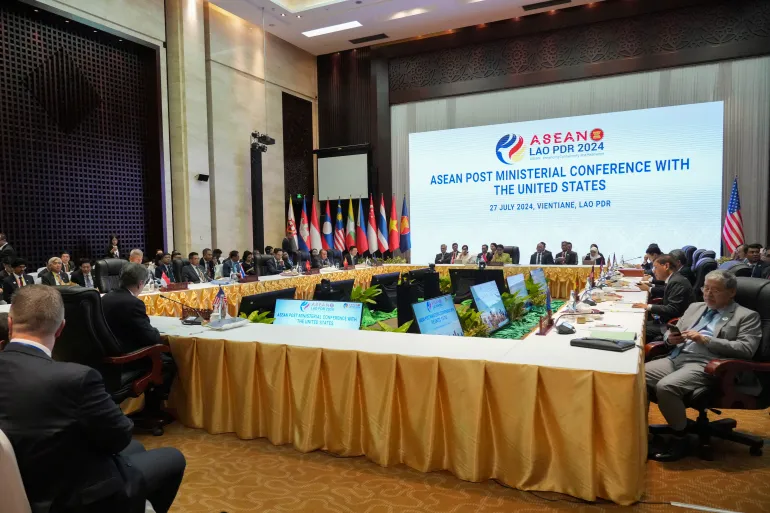ASEAN’s Top Diplomats Discuss South China Sea Disputes and Myanmar Crisis Under US-China Influence
The Association of Southeast Asian Nations (ASEAN) held a vital conference in Laos on Saturday, bringing together top diplomats from the region and beyond to discuss increasing tensions in the South China Sea and Myanmar’s protracted crisis. This high-stakes diplomatic event was also attended by significant international parties such as the United States and China, both of whom are vying for more influence in the strategically crucial region.
The South China Sea, a strategic waterway with abundant natural resources and major trade routes, has long been a source of conflict between various ASEAN member states and China. The issues revolve upon overlapping territorial claims and China’s sweeping maritime assertions, which have resulted in heightened military activity and regional instability. At the ASEAN meeting, top diplomats underlined the need of peaceful dispute resolution and adherence to international law, particularly the United Nations Convention on the Law of the Sea (UNCLOS).

The ASEAN Summit: A Platform for International Cooperation and Regional Stability
The conference was attended by significant persons like US Secretary of State Antony Blinken and Chinese Foreign Minister Wang Yi. Both aimed to deepen their countries’ ties with ASEAN members, emphasizing their strategic interests in the area. The United States has been loud in its support for freedom of navigation, and it has launched naval patrols in the South China Sea to challenge China’s territorial claims. Meanwhile, China has sought to strengthen its position and influence through infrastructure projects and economic collaborations under the Belt and Road Initiative.
Another critical issue on the agenda was Myanmar’s continuing dilemma, in which military authority has resulted in significant dissent and violence since the February 2021 coup. The ASEAN diplomats spoke about the deteriorating humanitarian situation and the necessity for a coordinated response. ASEAN has been chastised for its minimal role in resolving the conflict, with calls for the bloc to adopt a harder stance and more decisive action. The conversations underscored the complexity of dealing with the crisis, including balancing diplomatic engagement with Myanmar’s military leaders with support for democratic and humanitarian principles.
ASEAN Diplomats Gather in Laos to Address Key Regional Issues
U.S. Secretary of State Antony Blinken at the ASEAN Summit: Discussing South China Sea and Myanmar Crisis
The ASEAN meeting also provided an opportunity for broader discussions about regional security and cooperation. The participation of other significant powers, including as Russia, Japan, India, and Australia, highlighted the region’s geopolitical importance and the interconnection of global security concerns. These countries want to strengthen their ties with ASEAN, acknowledging the organization’s critical role in supporting peace, stability, and economic progress in Southeast Asia.
As ASEAN navigates these multifaceted difficulties, the Laos meeting emphasized the need of member nations working together to address them. The bloc’s ability to deal with complicated situations like the South China Sea conflicts and the Myanmar crisis will be critical in determining the region’s destiny.
Finally, the ASEAN meeting highlighted Southeast Asia’s major security challenges, including the South China Sea disputes and the Myanmar situation. The presence of major global entities such as the United States and China highlights the region’s strategic importance and ongoing quest for influence. As ASEAN diplomats work toward peaceful solutions, the outcomes of these meetings will have far-reaching consequences for regional stability and global relations.